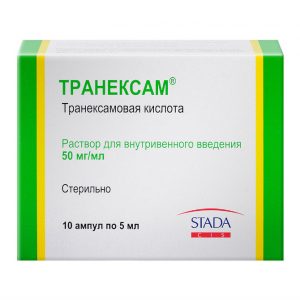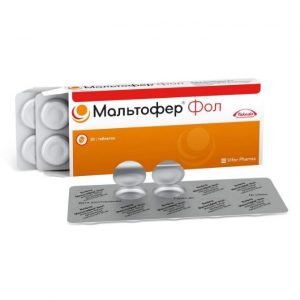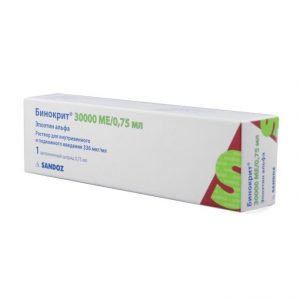Description
Pharmacological action
Antifibrinolytic agent is a competitive (at high concentrations, non-competitive) inhibitor of plasminogen activation and its conversion to plasmin. It has local and systemic hemostatic as well as anti-allergic and anti-inflammatory effects by suppressing the formation of kinins and other active peptides involved in allergic and inflammatory reactions. It has local and systemic hemostatic effects in case of bleeding associated with increased fibrinolysis (platelet pathology, menorrhagia). Also, tranexamic acid due to the suppression of the formation of kinins and other active peptides involved in allergic and inflammatory reactions, possesses anti-allergic and anti-inflammatory action. Tranexamic acid at a concentration of 1 mg / ml does not aggregate platelets in vitro, at a concentration of up to 10 mg / ml of blood does not affect the number of platelets, the coagulation time or various coagulation factors in whole blood or nitrate blood in healthy person. On the other hand, granexamic acid both at a concentration of 1 mg / ml of blood and 10 mg / ml of blood lengthens the thrombin time.
Indications
Distributed in the tissues relatively evenly (with the exception of cerebrospinal fluid, where the concentration is 1/10 of the plasma). Penetrates through the placental barrier (the concentration in the umbilical cord blood after administration to a woman at a dose of 10 mg / kg can be quite high, about 30 μg / ml fetal serum) and the blood-brain barrier (BBB). excreted in breast milk (reaching approximately 1% of the concentration in the plasma of the mother). It is found in seminal fluid, where it reduces fibrinolytic activity, but does not affect sperm migration. Transamic acid quickly diffuses into the joint fluid and through the synovial membranes, is found in the joint fluid in the same concentration as in blood serum. The biological half-life of articular fluid is about 3 hours. The initial volume of distribution of Vd is 9-12 liters. Binding to plasma proteins (profibrinolysin) – less than 3%.
In the blood, about 3% is associated with protein (plasminogen). The total renal clearance is equal to plasma.
Antifibrinolytic concentration in various tissues persists for 17 hours in plasma – up to 7-8 hours.
Metabolized to a small extent. The area of the iodine concentration / time curve AUC has a three-phase form with T1 / 2 in the terminal phase – 2 hours. The total renal clearance is equal to the plasma (7 l / h). It is excreted by the kidneys (the main way is glomerular filtration), more than 95% unchanged during the first 12 hours. After intravenous administration at a dose of 10 mg / kg for 24 hours, about 90% of tranexamic acid is excreted by glomerular filtration. Two tranexamic acid metabolites have been identified: N-acetylated and deaminated derivatives. With impaired renal function, there is a risk of cumulation of tranexamic acid.
Contraindications
Hypersensitivity to tranexamic acid or other components of the drug. Patients with a history of and with a risk of developing thrombosis when it is impossible to simultaneously treat with anticoagulants, active thromboembolic disease, including deep vein thrombosis, pulmonary embolism, cerebral thrombosis, acquired color vision impairment, subarachnoid hemorrhage (risk of developing edema and cerebral infarction), hematuria caused by kidney parenchyma diseases, simultaneous treatment with coagulation factor IX or anti-inhibitory coagulant complex. Pediatric use
There is no clinical experience with tranexamic acid in patients under the age of 15 years with menorrhagia.
Clinical experience in children under 2 years of age is limited, therefore tranexamic acid should be used in this category of patients only if the potential benefit outweighs the risk. The benefits of using antifibrinolytic drugs in newborns and children under 2 years of age remain debatable, since bleeding in this category of patients is more associated with the immaturity of the coagulation system than fibrinolysis.
Published data on the efficacy and safety of tranexamic acid use do not allow a final conclusion to be drawn on the benefits of tranexamic acid in infants, children under 2 years of age. Due to the physiological characteristics of newborns and infants (immaturity of the blood-brain barrier and the function of the nights), there is a potential risk of seizures associated with the use of tranexamic acid.
Precautions: Renal failure (risk of cumulation), bleeding from the upper urinary tract (risk of secondary mechanical obstruction with a blood clot), patients with a high risk of thrombosis (history of thromboembolic events or a family history of thromboembolism), disseminated vascular syndrome (disseminated) syndrome).
Special instructions
Before starting and during treatment, an oculist should be examined (visual acuity, color vision, fundus).
If visual disturbances occur during treatment, drug withdrawal is necessary. With hematuria from the upper urinary tract, there is a risk of secondary mechanical obstruction with a clot in the renal pelvis, urethra and the development of anuria. Tranexamic acid therapy is not indicated for hematuria caused by kidney parenchyma diseases. Under these conditions, intravascular precipitation of fibrin is often observed, which can aggravate the condition. In addition, in cases of massive renal bleeding of any etiology, antifibrinolytic therapy increases the risk of delayed clot in the renal pelvis.
Although clinical data do not show a significant increase in the incidence of thrombosis, a possible risk of thrombotic complications cannot be completely ruled out. Cases of venous and arterial thrombosis and thromboembolism have been reported in patients receiving tranexamic acid. In addition, cases of occlusion of the central retinal artery and central retinal vein have been reported. Several patients developed intracranial thrombosis during treatment with tranexamic acid, however, further research is needed to assess the significance of this potential risk.
There are no data on the use of tranexamic acid in women taking concomitant oral contraceptives.
In patients with a high risk of thrombosis (thromboembolic events and history, cases of thromboembolism in the family history), tranexamic acid should be used only in case of emergency and under strict medical supervision. The presence of blood in body cavities, for example, the pleural cavity, articular cavity and urinary tract (including the kidneys, pelvis, bladder) can lead to the formation of an insoluble clot in them due to extravascular coagulation, which may be resistant to physiological fibrinolysis . Patients with irregular menstrual bleeding should be given tranexamic acid only after establishing the cause. If the amount of menstrual bleeding is inadequately reduced during treatment with tranexamic acid, an alternative treatment should be considered.
The effectiveness of the drug in the treatment of menorrhagia in patients younger than 15 years of age has not been established.
Patients with disseminated intravascular coagulation syndrome who need tranexamic acid treatment should be closely monitored by a physician with experience in treating this disease.
Impact on the ability to drive transp. Wed and fur.: In case of adverse reactions from the central nervous system and / or organ of vision, you should refrain from driving vehicles or working with other mechanisms, requiring increased concentration and high speed of psychomotor reactions.
Composition
Composition per 1 ml
Active ingredient: Tranexamic acid 50.0 mg
Excipients: Water for injection up to 1 ml.
Side effects
From the digestive system: anorexia, nausea, vomiting, heartburn, diarrhea.
From the side of the central nervous system: dizziness, weakness, drowsiness, impaired color perception, blurred vision, convulsions (with rapid intravenous administration).
From the blood coagulation system: thrombosis, thromboembolism (the risk of developing is minimal).
From the cardiovascular system: tachycardia, chest pain, arterial hypotension (with rapid on / in the introduction). Allergic reactions: skin rash. itching hives.
Overdose
There is limited evidence of overdose cases. One case of overdose (37 g) has been reported.
Overdose symptoms may include dizziness, headache, nausea, vomiting, diarrhea, orthostatic symptoms and decreased blood pressure. The antidote is unknown. If an overdose is suspected, hospitalization is necessary. In order to help, symptomatic therapy, gastric lavage, activated charcoal are used for 1-2 hours after accidental ingestion of forced diuresis.
Storage conditions
At a temperature not exceeding 25 ° C. Do not freeze. Keep out of the reach of children.
Expiration date
3 years. Do not use after the expiration date indicated on the package.
Dosage form
injection
Appointment
Vzrosl m prescription
Indications
That bleeding




